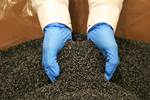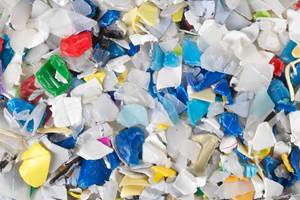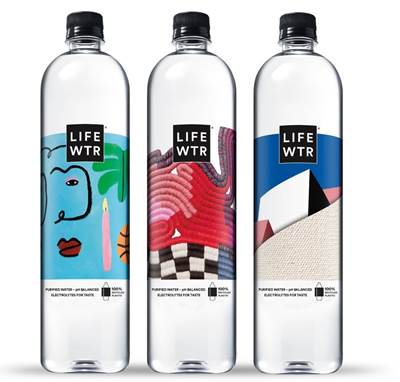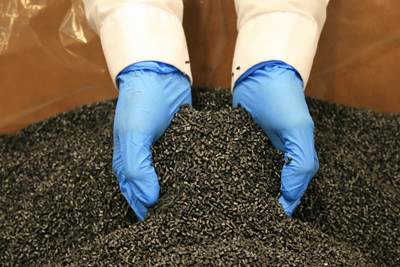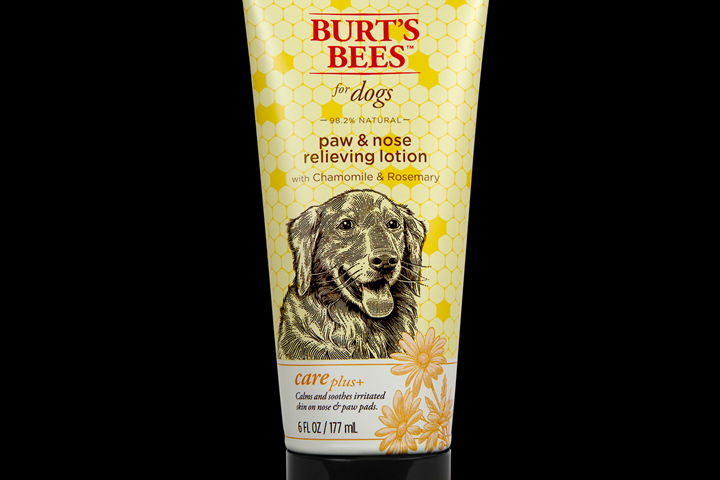
The Burt’s Bees for dogs package was Berry Global’s first commercialized post-consumer recycle tube, containing a maximum of 62% PCR.
For all the talk about a circular economy, it always boils down to one question: how do we get there as a society?
Many consumer-goods companies and retailers have committed to increasing recycled content in their packaging to an average of 25% by 2025, a steep climb from the current global average of 2%, according to the Ellen MacArthur Foundation. While some companies have pushed back their goals to adopt more recycled content by the later date of 2030, other companies are on their way to incorporating more recycled content right now.
It takes the entire supply chain to move in the same direction in order to attempt to even meet these goals, which is no small feat.
“We try to partner with both the molders who are trying to incorporate the technology, and the brand owners who have to use it in their product, to work on their sustainability goals and ensure the safety of the package,” said Tara Cary, market development specialist for cosmetics and personal care, in the Specialty Plastics unit of Eastman Chemical. “Think of it as a three-legged stool in that way—everyone has to play their part and do what’s necessary to help. We have an ongoing relationships with the brand owners and molders to roadmap what the brand needs.”
Plastics Technology checked in with several different companies, including brand owners, to learn more about the process to design for recycled content.
Material Selection and Requirements
Cary of Eastman says brand owners are trying to get the recycled content to meet their sustainability goals, and they’re trying to do it in the most efficient manner, while still maintaining a prestige look and feel, especially in cosmetics.
“They don’t want to retool their molds; don’t want to have to go through huge qualifications, if at all possible; and they want to meet the same physical requirements, such as durability, and the aesthetic requirements they already have,” she said. Eastman is addressing these needs with its Renew line of copolyesters produced by chemical recycling—depolymerizing, purifying and repolymerizing into as-new materials. “That’s what makes our Eastman Renew material so great, as it’s chemically indistinguishable from the heritage product they’re already using. So no tooling changes, no long drawn-out qualification, because you can’t tell the difference—it’s the same material.”
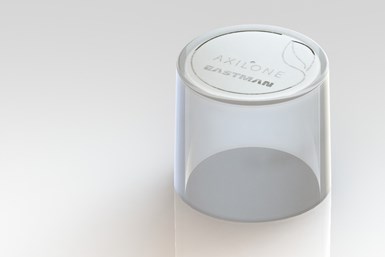
Axilone is the first manufacturer working with Eastman's family of Renew resins to obtain ISCC PLUS certifications for sites on three different continents.
Axilone Group, a French-based global manufacturer, makes a wide range of luxury cosmetics packaging using Eastman Cristal Renew copolyester, produced with Eastman's Advanced Circular Recycling technologies. With 50% certified recycled content derived from “molecular recycling,” Cristal Renew is part of a broad portfolio of sustainable resins now offered at scale by Eastman.
Last year, Braskem announced that by 2025, it plans to expand its “I'm green” portfolio to include sales of 300,000 tons (600 million lb) of recycled-content products per year. Geoffrey Inch, Braskem’s director of circular economy and sustainability for North America, says it’s important for everyone to be on the same page.
“Brand owners don’t want to retool their molds; don’t want to have to go through huge qualifications, if at all possible, and they want to meet the same physical requirements.”
“We talk with brand owners about what type of recycled content they are going to evaluate, what are the set requirements on the type of application and the certain type of materials depending on the application. We want to make our investments align with their goals and that’s why it’s important to collaborate across the value chain.
Inch says there is plenty of complexity with regards to adding in more recycled content. “For example, if you have a package in very bright colors, and the only recycled material to work with is black, it’s hard to utilize that material and that kind of disqualifies it from the process. So we understand that we have to provide a solution that fits with the requirements. We have one wide usage of virgin PP in the U.S., and we’re looking at how we can turn the product slate to incorporate recycled content and boost it to meet the requirements of brand owners.”
He sees an interesting growth path in using recycled PP in restaurant and retail packaging. “One key thing for the brand owners, and the design for recyclability, it’s how do we get there in a more simple structure and using a single material in as many applications as possible. Using a single material as much as possible requires less sorting and there’s more feedstock there with which to create circularity.”
According to Thorsten Leopold, dir. of international packaging technology for home care at Henkel, in 2020 his company used around 440 million PET bottles made of 100% recycled plastics for laundry and home-care products in Europe. “When it comes to designing packaging, we have to cope with different materials and requirements,” he says. “Whereas recycled material for PET bottles is available in very good qualities, we are facing a different situation with PE bottles, as most recycled materials are mainly available in grayish colors. A good solution is full-body sleeves that can be printed, placed around the product, and thereby hide the grayish color of the PE bottle itself.”
Berry Global sustainability director Diane Marret says it’s not so much that brand owners have materials they don’t want to work with, but more about how to align the right recycling stream with the application, which includes the material, process, part design and aesthetic requirements.

Azek will use Berry’s mixed-material, post-industrial scrap in the production of high-quality, sustainable building materials such as composite decking.
Sometimes companies can get around the issue concerning aesthetics of recycled plastics. Azek Co., a Chicago-based maker of residential and commercial building products, is using Berry’s mixed-material, post-industrial scrap in the production of high-quality, sustainable building materials such as composite decking. The recycled plastic comes from Berry’s operations across multiple facilities and divisions in North America. “They can use that scrap material in the core of the product, without affecting the aesthetic,” Marret says.
“When it comes to designing packaging, we have to cope with different materials and requirements.”
Berry is another company exploring chemical recycling. Known benefits of chemical recycling include the ability to recycle mixed plastic waste that would have otherwise been destined for landfill or incineration. Unlike mechanical recycling, the process of chemical recycling removes all contaminants, including inks and colorants, returning post-consumer plastic to a quality that is reportedly indistinguishable from virgin material and suitable for direct food contact.
Berry is working with Mondelēz International to supply packaging containing recycled plastic for the Philadelphia cream cheese brand. The package contains plastic material recovered using advanced recycling technology from Berry’s partnership with Sabic.
“You have to be cognizant of the end use, especially since it’s a food product, so in essence you have to match the right stream to the right application,” Marret said. “That’s where we get into the advanced recycling space and a key opportunity to make that alignment.”
Brand Owner’s Perspective
Logitech, a maker of cloud peripheral products, expects that by the end of 2021, its largest product portfolio will include recycled plastic in more than 50% of all computer mice and keyboards. These products’ plastic parts made with PCR currently range from 80% PCR content to 20% for the technically complex lighter color products. Logitech’s design goal is to continue to maximize the percentage of recycled content in each product.
Logitech is working with plastic suppliers to design new and stronger resins in a range of new colors. New resins will be used in Logitech products to give consumers more color options without compromising on product quality, while also being made available to other companies in an effort to help reduce the consumer-electronics industry’s carbon impact.
Robert O'Mahony, head of sustainability at Logitech, says the company works closely with partners on supply and compounding to redefine PCR resin that is equivalent to virgin. “We are working on expanding the palette of colors and increasing the percentage of PCR in those colors. The lighter the material, the more challenging technically to reduce the natural blemish when you use PCR material. We have been able to refine the raw recycled material that is coming to us, using a mix of virgin and additives. We’re figuring out how to improve compounding and molding characteristics to increase the percentage on some of the more challenging colors.”
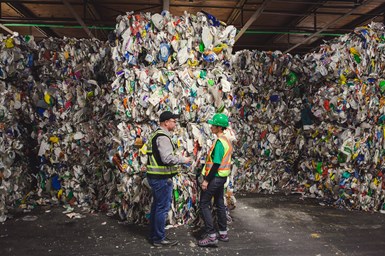
Monique Oxender (right), chief sustainability officer for Keurig Dr Pepper, at a MRF.
The lack of supply is still a huge barrier in the ability to incorporate more recycled content. On the mechanical recycling side, brand owners such as Keurig Dr Pepper (KDP) have been working on this issue. Last year, the company announced that all of the K-Cup pods the company produces are now recyclable. The extensive effort involved converting more than 100 manufacturing lines to produce the pods, now made from polypropylene.
“The lighter the material, the more challenging technically to reduce the natural blemish when you use PCR material.”
To ensure pods could be successfully recovered in recycling facility streams, in 2016 KDP pioneered tests using RFID technology to track tens of thousands of K-Cup pods in various recycling facilities across North America. Those tests demonstrated that the pods were able to pass successfully through the stream with other recyclables to be sorted out with other containers, a finding which was validated by the Association of Plastic Recyclers.
Monique Oxender, chief sustainability officer for KDP, says the company is continuing to work with communities to be able to accept, sort and recycle the K-Cup pods and other PP items. “However, we recognize that some MRFs (Materials Recovery Facilities) currently do not have the ability to properly sort for polypropylene, and we’re working to change that,” she notes. “From increasing our investments and expanding our partnerships to support equipment modernization and increased consumer education, to using increasing amounts of PCR for our products and packaging—we’re focused on improving PP recycling in North America.”
She went on to say that with its latest investment in The Recycling Partnership’s Polypropylene Recycling Coalition, KDP has committed to providing over $30 million for collaborative projects and partnerships across North America to build the circular economy.
Four MRFs in the U.S. will receive grants through the collaborative with the goal to widen the total nationwide acceptance of PP in curbside recycling programs, resulting in the recovery of a larger supply of PP that could be made into new products such as consumer packaging and automotive parts.
Related Content
Recycled Material Prices Show Stability Heading into 2023
After summer's steep drop, most prices leveled off in the second half.
Read MoreScaling Up Sustainable Solutions for Fiber Reinforced Composite Materials
Oak Ridge National Laboratory's Sustainable Manufacturing Technologies Group helps industrial partners tackle the sustainability challenges presented by fiber-reinforced composite materials.
Read MoreAdvanced Recycling: Beyond Pyrolysis
Consumer-product brand owners increasingly see advanced chemical recycling as a necessary complement to mechanical recycling if they are to meet ambitious goals for a circular economy in the next decade. Dozens of technology providers are developing new technologies to overcome the limitations of existing pyrolysis methods and to commercialize various alternative approaches to chemical recycling of plastics.
Read MoreLooking to Run PCR on a Single Screw? Here’s What to Keep in Mind
Just drop it in and mix it up? Sorry, there’s a lot more to it than that. Here is some of what you need to consider.
Read MoreRead Next
Leading the Charge: Brand Owners Moving to Boost Recycled Content in Packages, Products
Leading brand owners and a big-box retailer discuss their recycling goals, which will impact processors and the entire supply chain.
Read MoreBerry’s Bold Sustainability Benchmarks
Worldwide packaging behemoth Berry Global has staked out a market-leading sustainability position with ambitious near- and long-term goals. Executive VP and General Manager Brian Hunt discussed the company’s efforts with Plastics Technology, including a new line of PCR containing caps and closures.
Read MoreClosed-Loop Recycling Makes Old Printer Cartridges New Again
Canon runs a big recycling operation in Virginia where it collects and sorts toner cartridges, pelletizes the scrap, then molds new cartridges from the reclaim.
Read More




